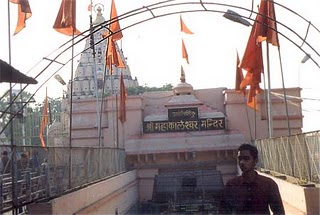Trimbakeshwar temple is a religious center having one of the twelve Jyotirlingas. The extraordinary feature of the Jyotirlinga located here is its three faces embodying Lord Brahma, Lord Vishnu and Lord Rudra. Due to excessive use of water, the linga has started to erode. It is said that this erosion symbolizes the eroding nature of human society. The Lingas at Trimbakeshwar are covered by a jeweled crown which is placed over the Gold Mask of Tridev (Brahma Vishnu Mahesh). The crown is said to be from the age of Pandavs and consists of diamonds, emeralds, and many precious stones. The crown is displayed every Monday from 4-5 pm (Shiva).All other Jyotirlingas have Shiva as the main deity. The entire black stone temple is known for its appealing architecture and sculpture and is at the foothills of a mountain called Brahmagiri.Three sources of the godavari originate from the brahmagiri mountain. Introduction of the holy place Shri Trimbakeshwar
500 years back from now there was built a city which later on became famous as Trimbakeshwar. In the period of the Peshwas regime Nana Saheb Peshwa had instructed to sonstruct the Trimbakeshwar temple and developed and beautified the city of Trimbakeshwar.
There is a mountain named the Brihmagiri Mountain 18 K.M. from the city of Nasik in the Nasik district. This is one of the parts of the Sahayadri Vallies. The city of Trimbakeshwar is located in the bottom of this mountain. This is a beautiful natural place with the cold weather as it is situated 3000 ft. above from the sea. There are two different routes to get to here. From Nasik to Trimbakeshwar, it is only 18 K.M. This route was built by the help of Shri Kashi Nath Dhate in A.D. 871. One can easily get amode of transport from here every hour.
The other easy route is the Igatpuri - Trimbakeshwar rute. This route is 28 K.M. long. Unlike the Nasik -Trimbateshwar road. Only some particular and pre-planned and certain mode of transport are available over here.
For the visitors coming from the North the Nasik-Trimbakeshwar route is the better one and more comfortable. The Municiple Corporation was established in Trimbakeshwar in 1866 A.D. The corporation is seruing and taking care of the devotees and tourists for 120 years. The corporation has cleansed,beautified and extended the important roads for the comfort of the visitors. The unforgettable establishment of the Phadanvees of the Holkars and the Peshawas are very much ornated and preserved.























































